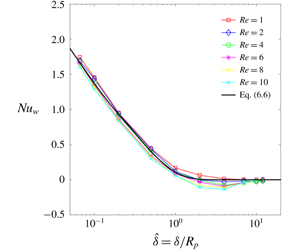Article contents
Heat and momentum transfer to a particle in a laminar boundary layer
Published online by Cambridge University Press: 24 February 2020
Abstract

Bounding walls or immersed surfaces are utilized in many industrial systems as the primary thermal source to heat a gas–solids mixture. Previous efforts to resolve the solids’ heat transfer near a boundary involve the extension of unbounded convection correlations into the near-wall region in conjunction with particle-scale theories for indirect conduction. Moreover, unbounded drag correlations are utilized in the near-wall region (without modification) to resolve the force exerted on a solid particle by the fluid. We rigorously test unbounded correlations and indirect conduction theory against outputs from direct numerical simulation of laminar flow past a hot plate and a static, cold particle. Here, local variables are utilized for consistency with unresolved computational fluid dynamics discrete element methods and lead to new unbounded correlations that are self-similar to those obtained with free-stream variables. The new drag correlation with local fluid velocity captures the drag force in both the unbounded system as well as the near-wall region while the classic, unbounded drag correlation with free-stream fluid velocity dramatically over-predicts the drag force in the near-wall region. Similarly, classic, unbounded convection correlations are found to under-predict the heat transfer occurring in the near-wall region. Inclusion of indirect conduction, in addition to unbounded convection, performs markedly better. To account for boundary effects, a new Nusselt correlation is developed for the heat transfer in excess of local, unbounded convection. The excess wall Nusselt number depends solely on the dimensionless particle–wall separation distance and asymptotically decays to zero for large particle–wall separation distances, seaming together the unbounded and near-wall regions.
Information
- Type
- JFM Papers
- Information
- Copyright
- © The Author(s), 2020. Published by Cambridge University Press
References
- 3
- Cited by

